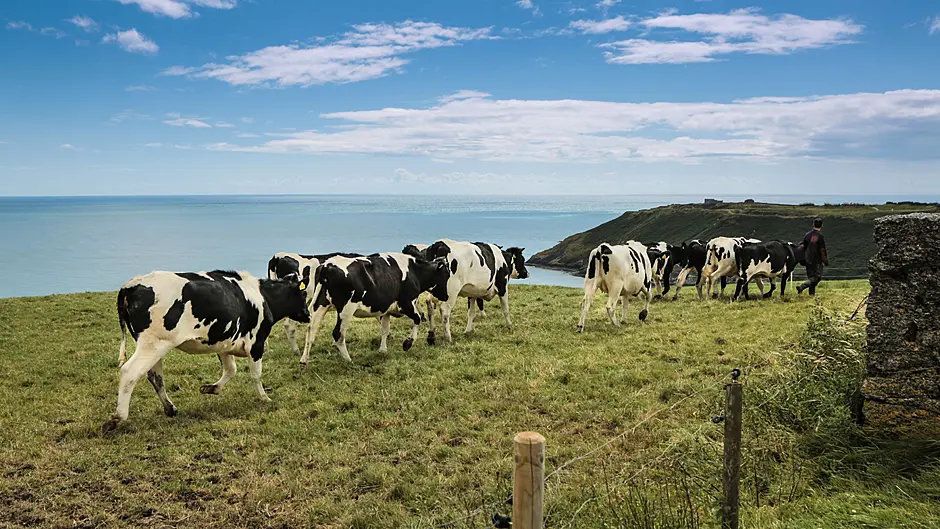THE fertility performance of your dairy herd depends on a number of factors.
To maximise these you need to: adequately feed your cows (energy, protein, minerals and vitamins); ensure the health status of your herd is good (check with you vet/agri advisor) and breed for a fertile cow.
You also need to carefully plan and manage the breeding season. As cows approach the breeding season, they must be on a rising plane of nutrition and maintaining body condition.
Grazed grass is the most economical way to feed the cow. It is critical to maximise the grass intakes daily.
Care is needed not to overestimate grass intakes. Overestimating grass intake by 1kg DM is the same as reducing concentrate feeding by 1kg.
If there is plenty of good quality grass available, the milk protein level in milk should also be increasing.
The protein level in your herd is dependent on the genetic potential in the herd, (your cows’ EBI).
If milk protein results are good and your grass graze outs are good (down to 4cm), in grass covers of 1400/1500kgdm, then hold concentrate levels.
If proteins are good and graze out is poor, then you need to reduce the concentrate level accordingly to improve graze outs. By doing this, you increase the grass being eaten by cows and also achieve better graze outs while making sure the cows are fully fed.
To support the energy requirements of a cow producing 2kg of milk solids on 16kg grass dry matter, you need to feed about 2kg concentrates.
Grass alone at this time does not meet the cow’s phosphorus, calcium, selenium, iodine and zinc requirements. Cows also need a daily intake of cal mag to prevent grass tetany.
Dietary deficiencies of these minerals have been linked to poor fertility, cystic ovaries, anoestrus, irregular or supressed heats and early embryonic death.
Depending on the performance of the cow, even though her energy demands may not require concentrates, feeding 1/1.5 kg of concentrates may be one of the cheapest and, importantly, the most effective way of supplying minerals in advance of and during the breeding season.
In 2021, the national average six-week calving rate was 67%. In a 100 cow herd it means that 67 cows calved in the first six weeks, including cows and heifers. The number of April, May and June calvers was 12%, 7% and 2% respectively.
The reproductive cycle of the cow requires a period of rest and recovery before she can go back in calf again.
Identify later calving cows and any cows with issues – this group includes cows calved within four weeks of the start of breeding season, they warrant special attention to help ensure that they go back in calf.
This includes cows with body condition score (BCS) of less than 2.75 at mating start date (MSD).
By identifying cows that had difficult calvings, milk fever, lameness, ecoli, mastitis etc, enables you to pay closer attention to pre-breeding heats and use veterinary intervention early if necessary.
Milking once-a-day (OAD) on low SCC cows, late calvers or thin cows, has proven to be very useful to get these cows back in calf in the breeding season. OAD milking reverses the trend towards body condition loss in early lactation and speeds up the resumption of their reproductive cycle. Cows on OAD have a higher conception rate to first service.
Using the once-a-day approach means that cows are typically inseminated within 50 days of calving. There are a variety of hormonal treatments to induce heat in cows that have been calved greater than 30 days or more and not cycling. If in doubt, talk to your vet.
The start of AI is dictated by your planned start of calving date. To achieve a high six-week in-calf rate, have the maiden heifers calving in February. Breed for enough replacements from the highest genetic merit cows (using EBI/Milk recording reports). Decide which heat detection aids you are going to use and calculate the number of AI straws to be required.
Your ICBF herd EBI scorecard can help to establish what the herd’s genetic strengths and weaknesses are. Select a team of high EBI AI bulls that will improve the strengths and counteract the weaknesses in the herd.
Use a team of bulls in equal numbers from the ICBF dairy active bull list to ensure you are making good genetic progress. Target high-EBI females, typically maiden heifers, first and second calvers for the next generation of replacements.
The ICBF herd plus sire advice tool is very useful for allocating your selected bulls to the cows, based on their strengths and weaknesses. For more information on breeding, contact your Teagasc advisor.
• Pauline O’Driscoll is a business and technology dairy advisor based in Skibbereen.









